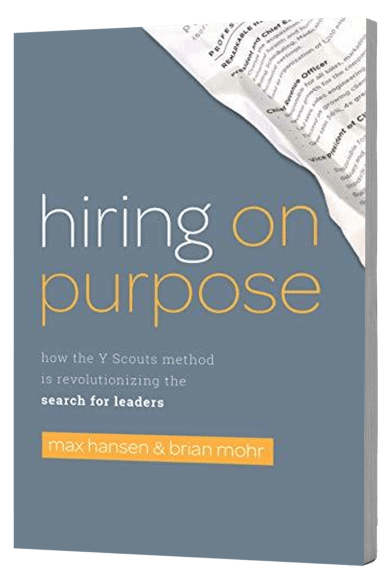You don’t decide on any old restaurant when planning a special dinner. You have a clear picture of the type of food, price, location, atmosphere, and service that you want to make the night a success. You use that picture to compare the options and determine the place for the occasion.
Hiring an executive has a greater impact on your business than any meal, so you can’t rely on generic job descriptions, resume highlights, previous experience, or industry standards to find the right candidate. You need to define what success looks like for this executive in your company before you ever begin your search.

Table of Contents
ToggleDefine Success Outcomes
First, define success for the executive you want to hire and condense the picture of your perfect leader into three main criteria. It is not easy, but purposeful, successful hiring is worth the effort.
Align to Your Goals
Depending on your goals, an executive candidate with great experience could still be the wrong fit for your company. Outline your business trajectory to find a successful leader who directly aligns with your future success.
Where is your company headed in 12 to 36 months? Do you need to address pain points to move forward? Are other executives retiring or changing roles? Are you entering new markets, undergoing a digital transformation, navigating a merger, or scaling a core business line?
Once you’re clear on your strategic priorities, you can reverse-engineer the kind of leadership required to meet them. For example, a company preparing for rapid growth needs an executive with a track record of building scalable systems and the ability to rally teams through ambiguity. Alternatively, a business that needs stability and fiscal discipline searches for someone who values process, data-driven decisions, and stakeholder alignment.
Work with Your Stakeholders
Defining success shouldn’t happen in isolation. Different board members and C-level leaders have different ideas about success. Alignment is critical to make the right hire.
Work with your stakeholders to create a success profile with agreement on goals, behaviors, timelines, traits, and evaluation criteria. Include your human resources team or executive recruiting consultants to ensure you have covered all aspects of their hiring process. When everyone’s on the same page, you have a foundation for hiring the right executive and a smooth onboarding process.
Clarify What Success Isn’t
Between you, your stakeholders, and your hiring team, you may have a million goals for your company. Prioritizing and limiting your success outcomes to three to five is hard. But you can streamline the process by knowing what you don’t want in a leader.
Knowing what kind of food you don’t want for your dinner narrows down restaurant options, and knowing what success doesn’t look like for your company puts things in perspective for your executive success outcomes.
Consider experiences with past leaders. Maybe your last executive hire was brilliant, but lacked the emotional intelligence to motivate your team. Or perhaps a former CEO was great at strategy but didn’t follow through on execution. These lessons give you valuable insights into what to prioritize this time around.
Success isn’t always about achievements on paper. How leaders impact the people they work with is just as important as the results. If what you dread the most is an executive who strains relationships with your vendors, clients, and staff, you have defined a successful outcome: a leader who improves relationships and morale across your company.
Translate Success into Action
You can’t stop at abstract goals like “drive innovation” or “improve operations.” Your three to five success outcomes should tie to clear key performance indicators (KPIs). These responsibilities are the yardsticks you’ll use to assess whether your executive is making a difference.
Ask yourself:
- What does a successful first 90 days look like for this leader?
- What data should your new hire analyze in the first three months?
- What should the first presentation to the stakeholders look like, and when should it be?
- What relationships should they build within the first year?
- What initiatives should this leader launch or improve within six months?
- What metrics should they move the needle on in year one?
If your manufacturing company is searching for a Chief Marketing Officer (CMO), a KPI for your successful executive might be a 40% increase in marketing-sourced leads by year one. Or their first presentation to the board should outline a plan to reduce customer acquisition costs by 20% over the next 24 months.
Success should be tangible, specific to the role, and related to your company’s needs. When you define it clearly, you empower your new executive to hit the ground running and hold themselves accountable to the same standards you do.
Improve Your Hiring Process
Success outcomes can guide every step of your hiring journey. Build job descriptions, filter resumes, conduct better interviews, and use assessments that measure a candidate’s ability to deliver on your expectations. Then you can be sure you are hiring specifically for your needs.
Instead of asking, “What are your three strengths?” you ask, “How have you improved gross margins in a high-growth environment before?” Instead of being impressed by a compelling presentation, you seek evidence of the candidate’s commitment to innovation in the presentation.
Support Long-Term Success
Defining success outcomes helps you hire the right executive and can also help support your new leaders’ long-term success. Provide your executive with the resources, mentorship, and access they need to thrive. Make introductions. Set expectations. Create a feedback loop that allows for ongoing recalibration.
Too often, newly hired executives jump into ambiguous situations without a clear understanding of power dynamics, existing pain points, political landmines, and stakeholder expectations. If you want your hire to succeed, share that context upfront.
Purposeful Executive Hire
When you articulate the outcomes that matter, expectations for progress, and non-negotiable leadership traits, you’re no longer picking any old candidate to lead your company. You give candidates a clear target. You give yourself a stronger focus. You hire the kind of leader who will fit right in while leading your company to better places than you’ve ever been before. That’s a win for everyone.



